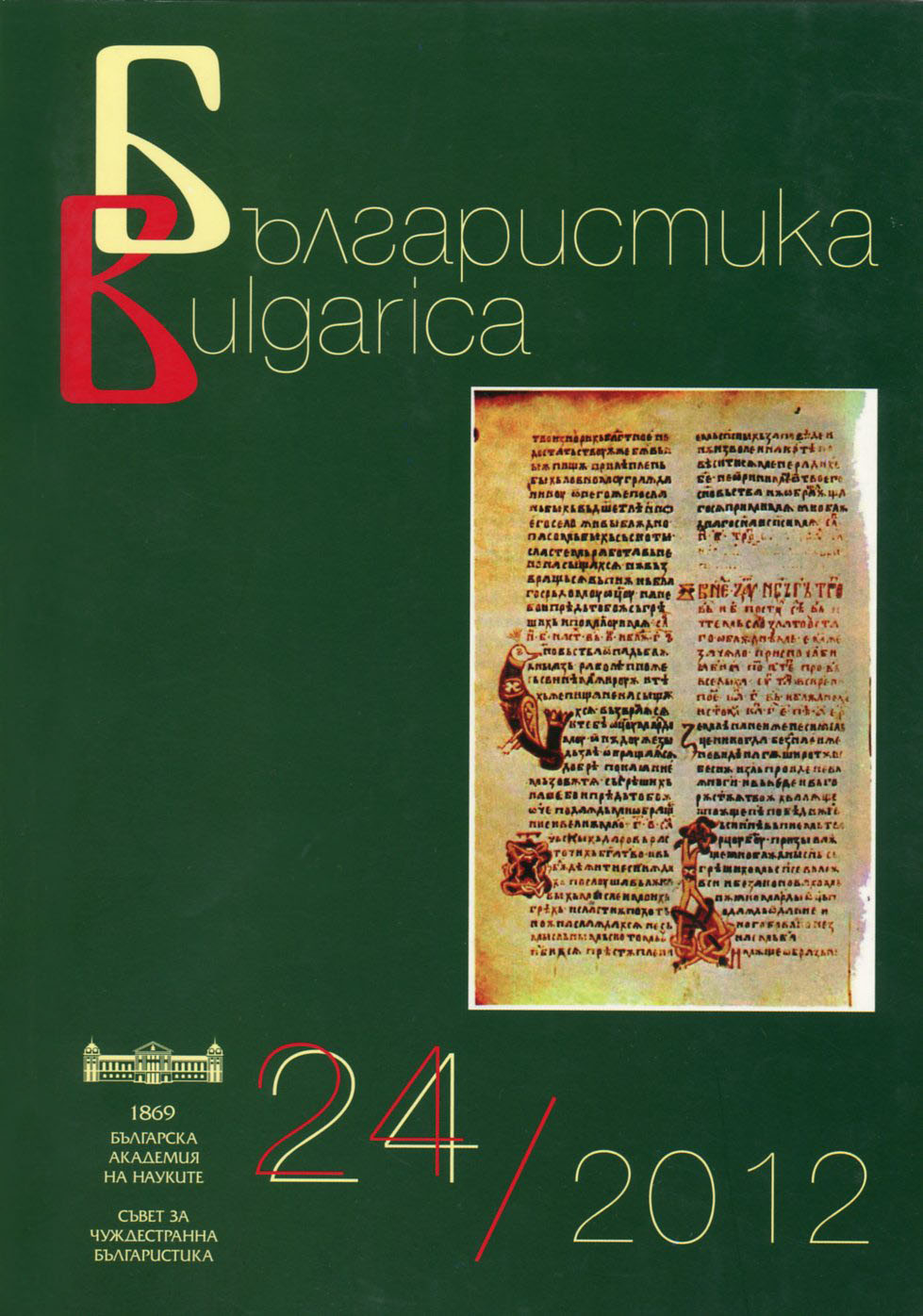
We kindly inform you that, as long as the subject affiliation of our 300.000+ articles is in progress, you might get unsufficient or no results on your third level or second level search. In this case, please broaden your search criteria.

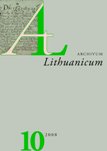
In the Purpura manuscript (approximately the middle of the nineteenth century), written in the North Lowland (Žemaičiai) dialect, all Polish vowel letters are used to denote monophthongs (except for Ó ó, so-called <o> kreskowane The graphemes A a, E e only occasionally express the long vowels [a∙], [e∙]: most often they are replaced by ai, ei or aj, ej type digraphs; hypercorrect forms are frequent in definite forms of adjectives: [a∙], [e∙] → aj, ej and so forth. The characters Ą ą, Ę ę mark both long nasal mid vowels, that originate from *, * (← *an, *en), and optional nasal allophones of /ọ/, /ẹ/ phonemes: denasalization of phonemes is a rather late alteration. I i that mark the high vowel [i] in flexion were well differentiated from Y y which denote the mid vowel [ẹ] according to the tradition. In absolute word initial position, however, the letters I i are written instead of expected Y y (with certain rare exceptions): apparently graphic neutralization of <y> ↔ <i> → <i> / #— takes place; the lack of Y y in word initial position in Polish orthography explains this. The letter y [ẹ] happens to be written also in unaccentable word medial position and in unaccented endings in cases where Žyvatas (Ziwatas, 1759) very consistently had e [e]. The phonetic value of the polyfunctional letter U u of Žyvatas and of many other North Lowland dialect texts was successfully divided into two: U u and O o. The attribution of new additional phonetic value to the graphemes O o (along with the main value O o [uo]) enabled separation of the mid vowels [ọ], [ọ.] from the high vowels [u], [u.], that were marked by the traditional symbols U u.
More...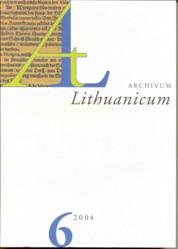
Linguistic analysis of Antanas Baranauskas' (1835-1902) Diary (1853-1856) proves that the author recorded it in a Polish dialect that was spoken in the region of Kaunas (Lithuania) at that time. His Diary reveals some phonetic, grammatical, and lexical features typical for that northern borderland variety of the Polish language. There are numerous examples of phonetic features that are not different from the contemporary Polish usage, but hardly any of them were present in the standard Polish of the nineteenth century. Baranauskas used many phonetic features that were characteristic for the northern borderland Polish dialect, e.g., different from the standard Polish distribution of <o> and <ó>; pronunciation of unstressed [e] and [o] as [a]; reduction of unstressed vowels; secondary palatalization and dispalatalization, especially dispalatalization of [n'] and palatalization of [s], [z], [c], [dz] in the position before [k']. The two latter cases can be explained by the interference from the Lithuanian language. There is assimilation (and simplification) of sequences (units) of palatalized consonants and fluctuation of alveolar and dental consonants, which are characteristic to Lithuanian (not Polish). There are also some cases of hypercorrection.
More...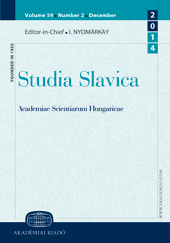
It is the theoretical background of the linguistic image of the world that serves as a base to the author to present Slovenian and Slovak magic formulae as the archaic strata of the language. She has chosen texts of the same type from the scope of Slovenian and Slovak peasants’ way of healing. The Slovak texts were collected by the author at the end of the 20th century, while the Slovenian texts which were set down earlier are quoted from Vinko Möderndorfer’s work. Apart from the common Central European attitude, the author also points out the unique, national, and linguistic features, all reflected by the linguistic image of the world.
More...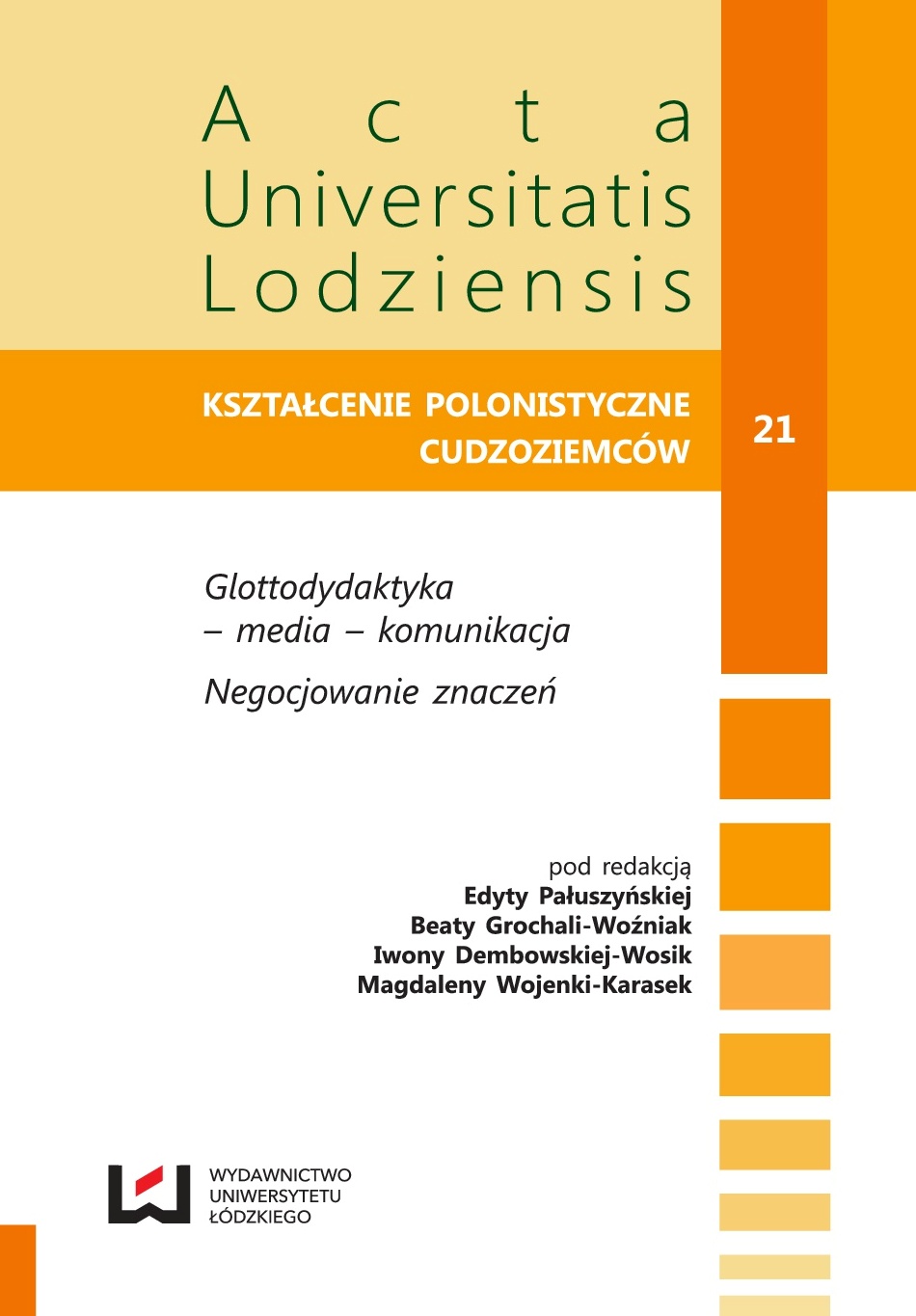
The study is concerned with the idea of polishness as a bisemic concept. It reveals the complexity of references connected with this idea, amongst the teachers as well as amongst the students of PAFL (Polish as Foreign Language) courses who have Polish origins. The article also seeks to define the factors influencing the understanding of polishness by the PAFL teacher and young Poles from the East. The teacher’s concept of polishness is formed by years of humanistic studies. Still, social changes and tasks set by the glottodidactic course confront that concept with the one formed in different social groups, like PAFL students. Sociological investigations indicate that the real attitude of Poles to their cultural heritage differs from the one created by mass media. The criteria of polishness set by the young generation of Poles (born in Poland), formed the basis of a questionnaire aimed to analyze the attitude of PAFL students. The results show that the majority of students officially belong to the Polish society, with 54% emotionally identifying themselves with it (and 52% with the Roman Catholic faith), while the identity of the rest cannot be unequivocally described. 88% of them had been learning Polish before, and 96% declare familiarity with Polish customs, while only 25% practice them. The majority (66%) would like to stay in Poland after having graduated, and none of them opposes to this idea.
More...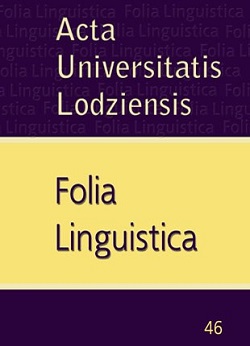
This work addresses the problem of cabaret groups and sketches. First of all, it describes and analyses the linguistic picture of the Polish history, including Polish stereotypes (e.g. the stereotype of a German or Russian person), in sketches of modern cabaret groups. This article presents the linguistic methods of creating a comic interpretation of history used by the authors of sketches. As a result of data analysis, three kinds of sketches are distinguished: historical ones, sketches based on convention, and manners sketches.
More...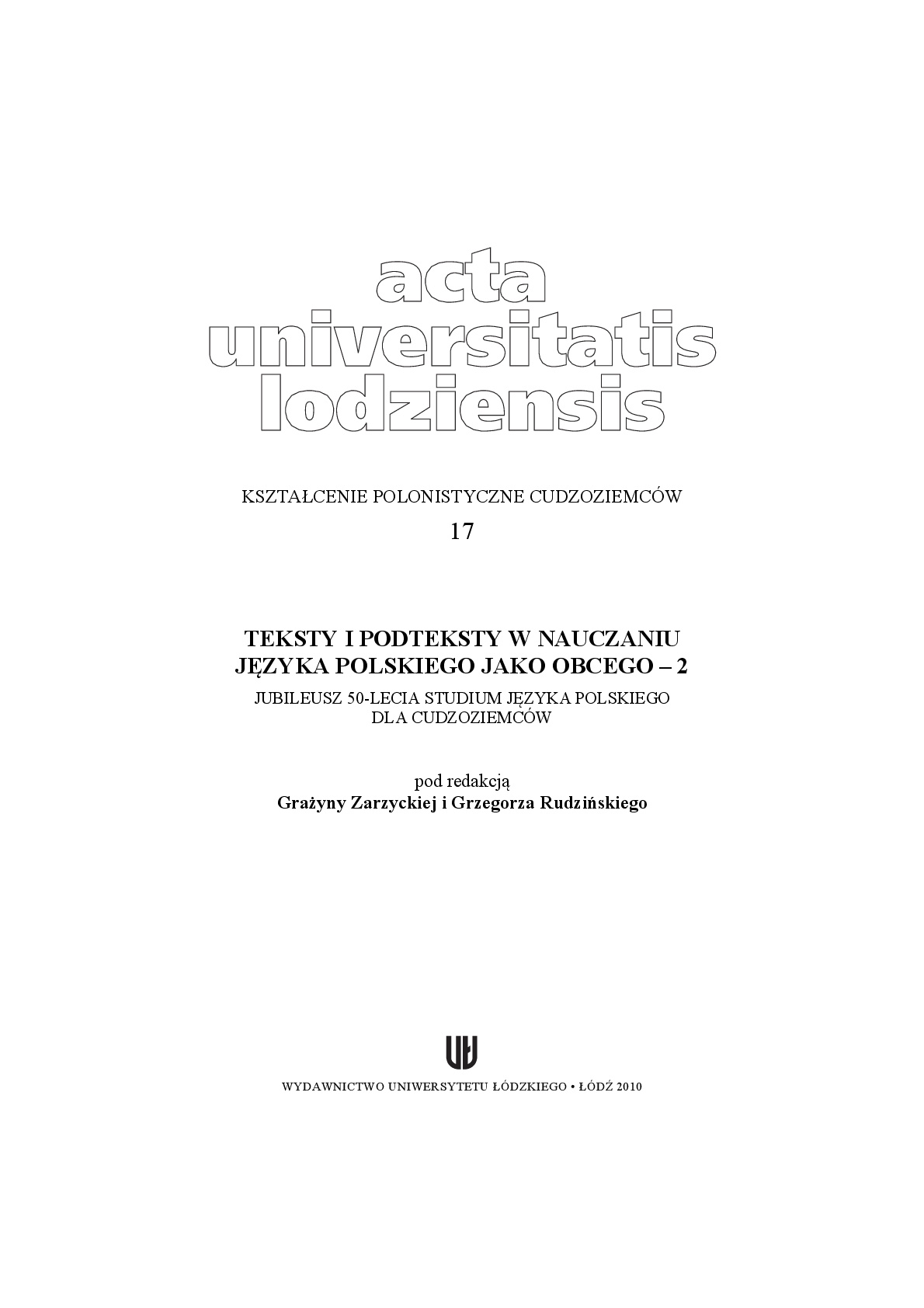
We współczesnej nauce o kulturze często namysłowi badawczemu poddawane jest zagadnienie antropologii podróży oraz sposobu turystycznego oglądu świata. Badacze wskazują, że obecnie mamy do czynienia z modą na podróżowanie. Jednak peregrynacja nie jest już rozumiana jako głęboka penetracja interioru kulturowego, w który wchodzi „obcy kulturowo”, lecz staje się powierzchownym byciem w atrakcyjnej (bo odmiennej) przestrzeni kulturowej, człowiek zaś podążający do innej kultury nie jest podróżnikiem, a zmienia się w turystę. Zatem porzuca aspirację znawstwa i wielopoziomowej interpretacji tego, co obserwuje na rzecz szukania turystycznych atrakcji1 i zaspokajania potrzeby przyjemności. Turystę cechuje zatem bierność poznawcza – sam nie szuka, czeka, aż inni mu wskażą. Łatwo także zaspokaja swoją ciekawość, zatrzymując się na płaszczyźnie, którą specjalnie dla niego przygotowano i traktuje ją jako jedyną wykładnię danej kultury.
More...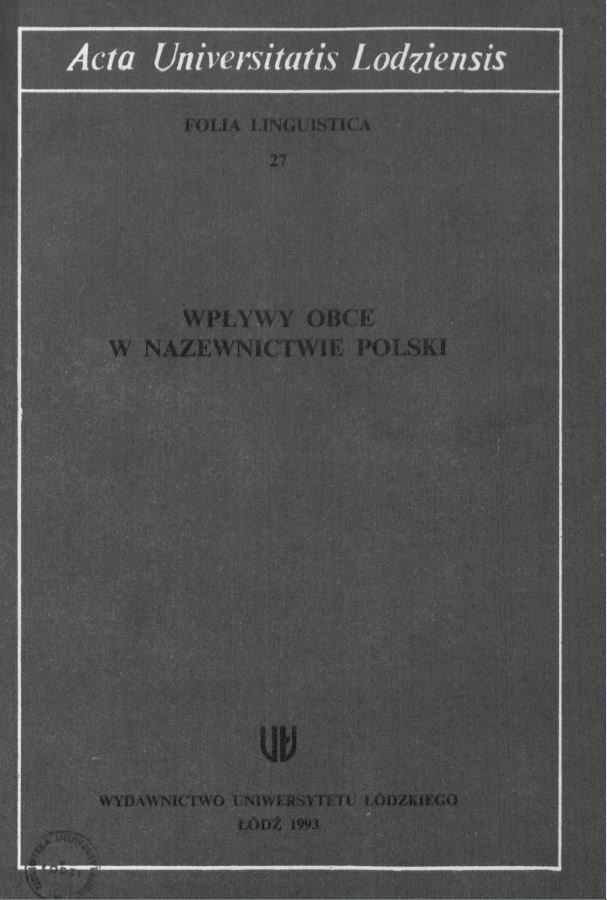
Aufgrund der analysierten Anthroponyme. deren phonetischer und semantisch-struktureller Form, kann man feststellen, daß in der genannten Starostet (im 16. und 17 Jh.) ostslawische Elemente dominieren. Es handelt sich hier um typisch ostslawische phonetische Merkmale, wie pleophonie, sth. h anstelle von g, Übergang des urslawischen in u usw. Wenn es um die Struktur der Anthroponyme geht, so begegnen hier neben gemeinslawischen Formen auch solche Namen, die typisch ukrainisch, belorussisch bzw. ostslawisch schlechthin sind. Im 16. Jh. verwundert fast die Dominierung des ostslawischen Suffixes -ewicz -owkz. Im 17. ЛЬ wird es konsequent durch das gemeinslaw. Suffix -ik - vk verdrängt. Darüber hinaus ist hier auch das neue patronymische Suffix -uk[-czuk ukrainischer Provenienz deutlich präsent. Das zu belorussischen Formanten gerechnete Suffix -eniu weist eine größere Produktivität im 17. Jh. auf. andere gemeinslawische Suffixe kommen nur vereinzelt vor. Im Quellenmaterial gibt es Beweise dafür, daß in den genannten Starosteien auch spärliche Spuren jüdischer und litauischer Besiedlung vorhanden sind.
More...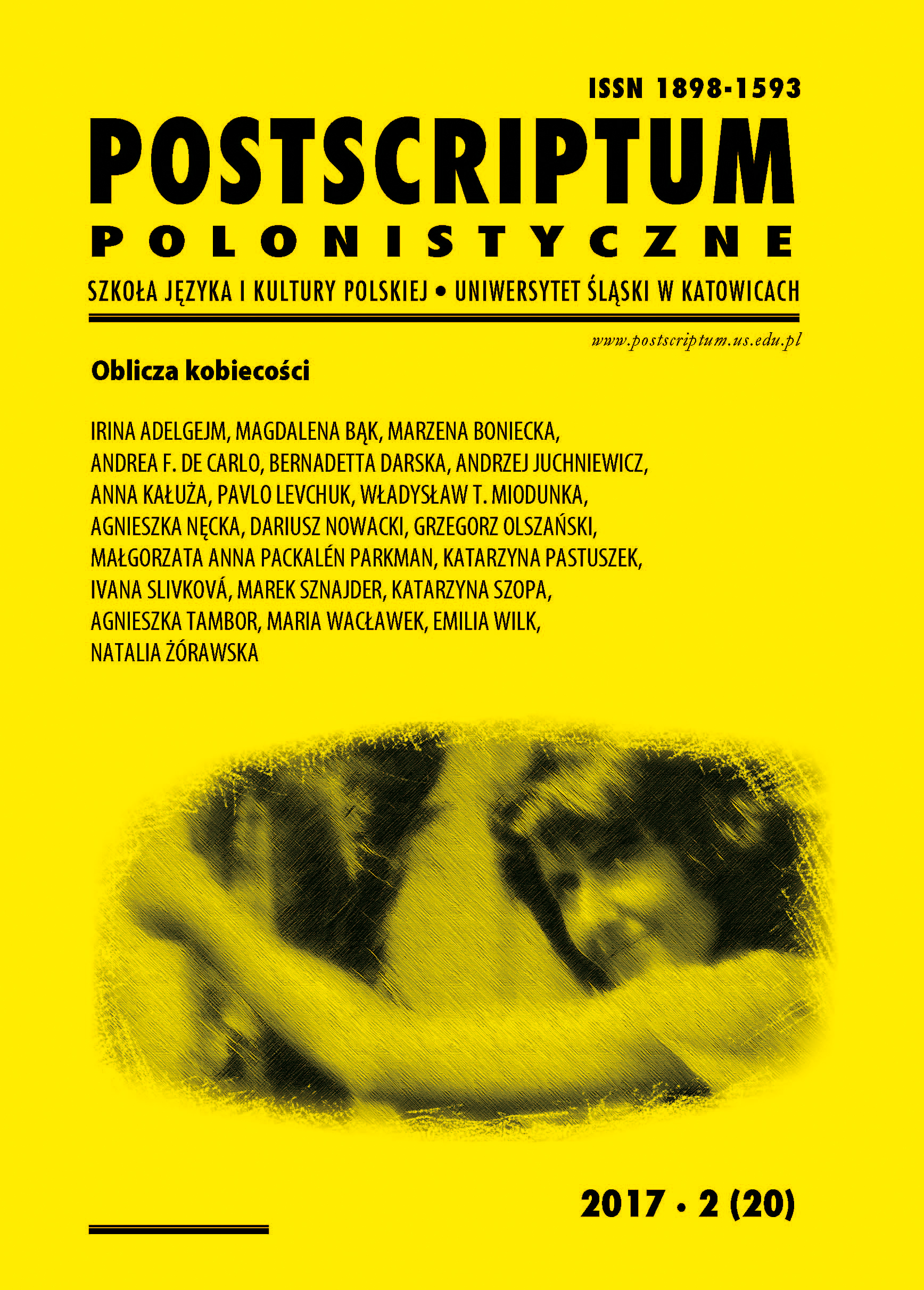
The article discusses the literary representations of the experience of unwanted pregnancy and abortion in new women’s prose. The author of the article refers to the novels published between 2003 and 2016. He considers the previously conducted research on the same subject (especially that of Agnieszka Mrozik). However, he concentrates mainly on the prose created in the last few years. He is above all interested in changes regarding the problem of unwanted pregnancy and abortion that occurred after 1989. When writing about this aspect of female experience has appeared in new prose, it is usually about the past and used to question the morality of the Polish People’s Republic. Recently the problem of unwanted pregnancy seems to be non-existent as all issues pertaining to maternity are solved in a similar way: despite initial hesitations the heroines of the novels decide to have babies and never regret their choice. In this context Aleksandra Zielińska’s novel „Przypadek Alicji” („The case of Alice”) seems to be especially interesting. Considerations concerning this novel appear in the final part of the article.
More...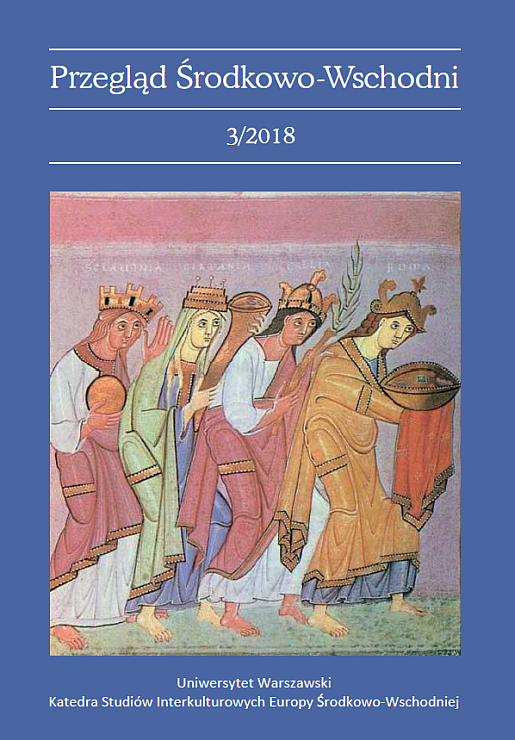
The article is devoted to the phenomenon of the bilingualism in the written text, it means intentional usage of two languages in the literary work, requiring high language (and communicative) skills not just from the author, but also from the audience. Under the analysis are different types of the literary bilingualism differing from their communicative strategy and structure of the communicative system as whole. Thus, macaronic poems producing comic effect are related with a such of sociocultural situation, when relations of languages evaluated as “high” and “low” are settled hierarchically. In the regions, where mass multilingualism is based on the long terminated language and culture contacts, bilingual texts often are composed with code-switching registed every time when the “speaker” is changed, because the languages are associated with the certain societal and cultural stereotype. Under the ideal situation of the balanced bilingualism – real or desirable and constructed, for example, in order to format political solidarity – the bilingual texts are created, where languages are independent, code-switching depends not from the “speaker”, but from the communicative strategy. Deliberate model of language behavior in such a case has a political or ideological ground and fixes ties between political identity and language consciousness. The analysis has showed, that situation of code-switching in one text is unstable and as such tends to the “mono” linguality.
More...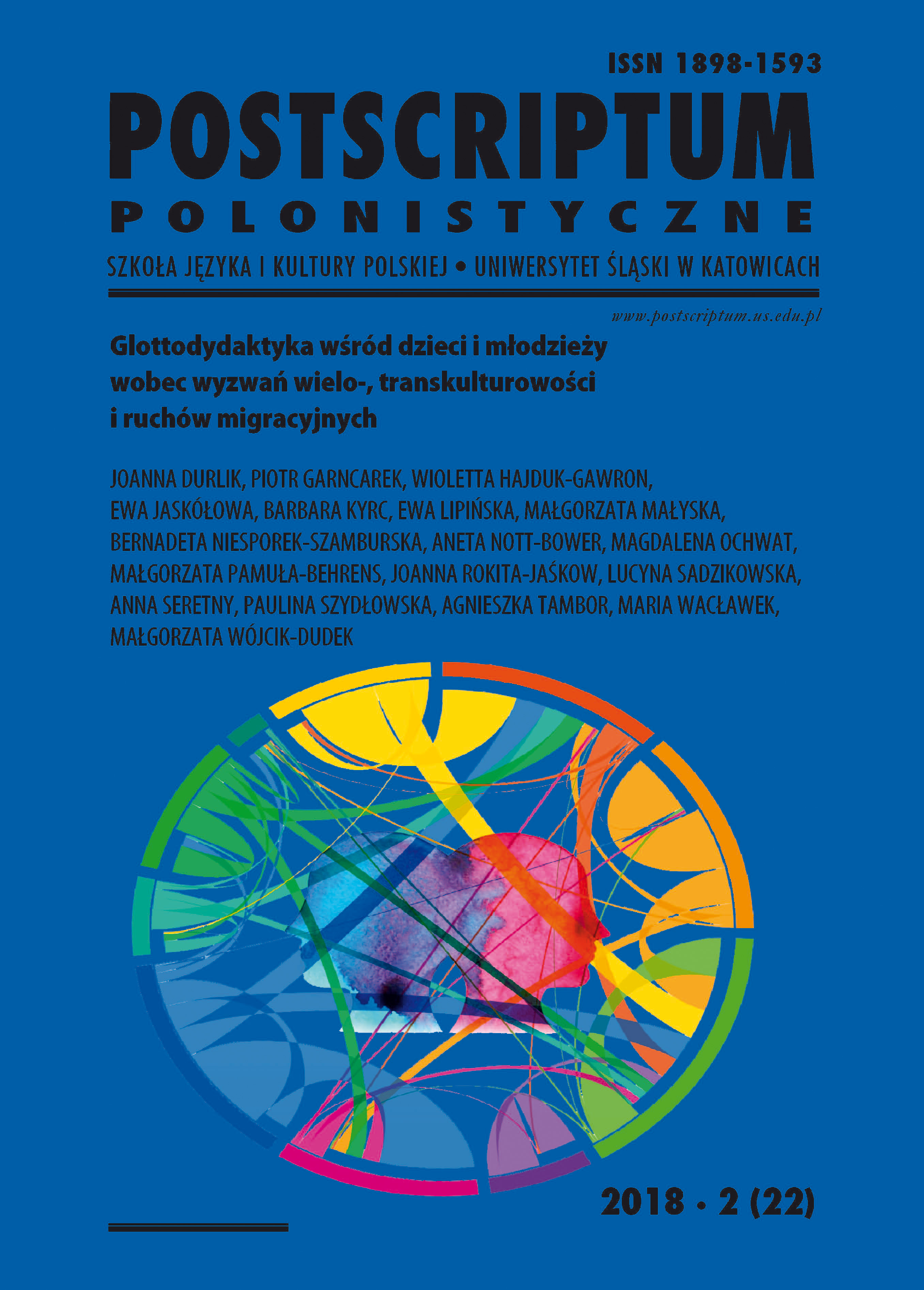
The article author presents her own project of teaching Polish as an inherited or second language to children aged 5 to 9. It is based on the constructivist theory of teaching, Ingarden’s theory of literary work cognition and Polish literary texts. The essential part of this project is education through various games that systematize the material presented during each lesson. The author highlights the importance of enactive text cognition, passing from an object recognized through various senses to its symbolic representation, from literality to metaphor. The literary text becomes yet another source of language experience for children.
More...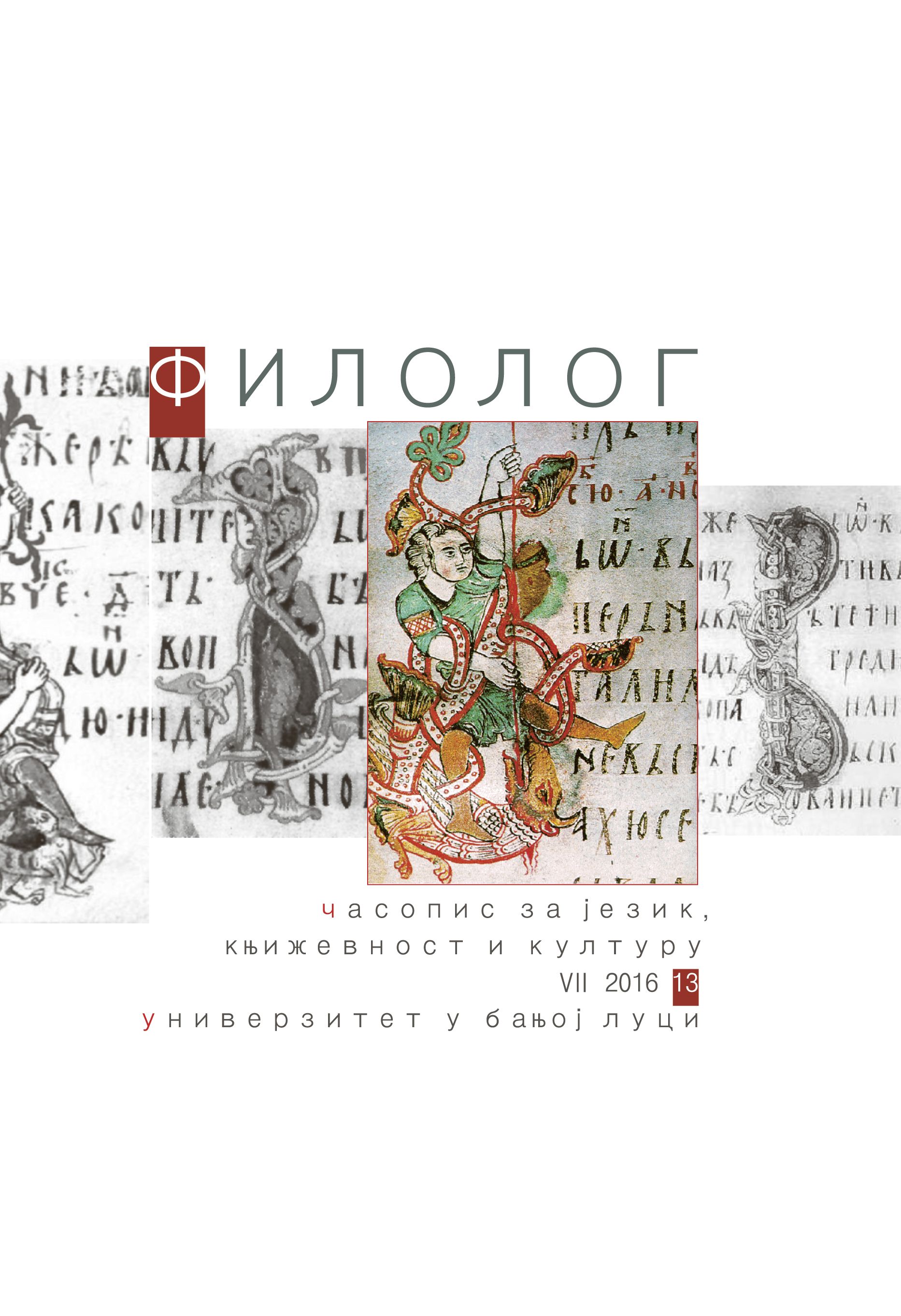
Review of: IWоBA VIII (International Workshop on Balto-Slavic Accentology) – Referati VIII međunarodnog skupa o baltoslovenskoj akcentologiji (Novi Sad, 6–8 jul 2012), Slavistički zbornik (2014), Radmilo Marojević (ur.), Novi Sad: Biblioteka Matice srpske – Filozofski fakultet.
More...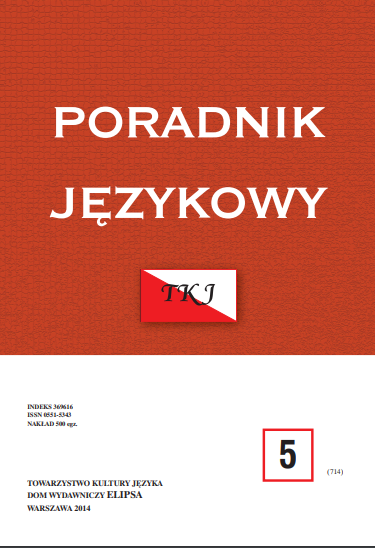
This paper presents arguments substantiating the need to undertake systematic research on the syntax of the official Polish language of the partition and post-partition periods. The absence of such research, the practice of formulating evaluations based on random examples, and referring to predecessors’ opinions results in the establishment of negative judgements about the level of official Polish in the period of rebirth of Poland. The sources of such opinions can be found in the debate occurring in “Poradnik Językowy” (“The Linguistic Guide”), “Język Polski” (“The Polish Language”), and other interwar publications on Polish usage. The popular stereotypical judgements about the impact of German on the syntax of official documents require verification also in light of research on the official and legal variant of Polish of the pre-partition period so that it is possible to determine which properties constitute the Old Polish heritage and which are the legacy of the partition period.
More...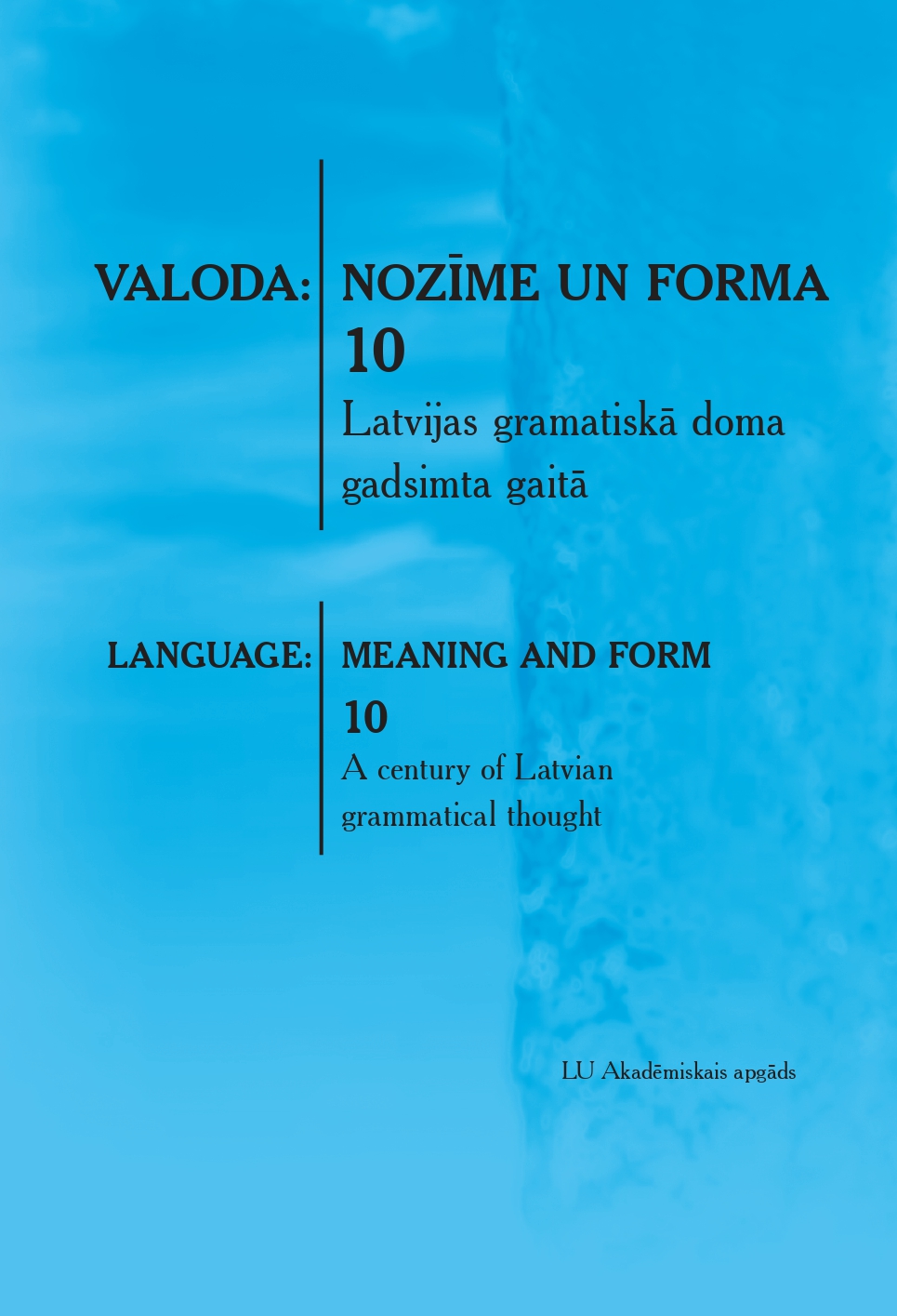
In our paper we describe a specific, Latvian two-word construction consisting of a verb preceded by an adverb derived from the same verb by the suffix -in-/-tin- (e.g. bērtin bērt). We are interested in how a given language element, apparently archaic and typical of Latvian folk songs (dainas), is used in today’s language. Some research questions are articulated, including one that goes beyond the specific realm of the Latvian language (how can these constructions be translated into other languages?). We search for the construction in the available Latvian corpora (LVK2018, lvTenTen14, InterCorp lv v11, Rainis and SENIE) and compare the resulting occurrences with a description in the current Latvian linguistic sources: both grammars and dictionaries. Deviations from the norm are treated descriptively in this article, as the speakers’ aim is to achieve a communication goal rather than their mistakes, as well as the creative development of this construction up to the present. The article is supplemented with an appendix: alphabetic lists of analysed lemmas along with their frequency.
More...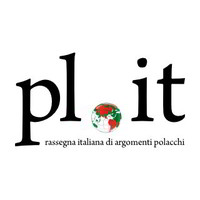
The interest of Polish scholars in literary works written in Ruthenian or in Polish language in the borderlands of the Commonwealth varied in different periods. By the end of the 19th and the beginning of the 1930s, Poland was rather focused on the construction of her new national state and the accentuation of her civilizational mission towards Eastern Slavic literature. After World War II, the new borders of the Polish state under Communist rule directed the attention of Polish scholars and cultural dealers toward a new national conception, whose goal was to eradicate the memory of the Commonwealth and to canalize the intellectual efforts towards “truly” Polish heritage, anti-German antagonism and politically correct ideologies. However, some groundbreaking works were written in the 1960s. Radical changes appeared after 1989. Publications multiplied exponentially in the 1990s and 2000s. Post-colonial studies emerged. In Polish scholarship and culture, two main trends may be indicated: on the one hand, the need to analyze the cultural, linguistic and literary specificities of the borderlands of Ukraine and Belarus in the Lithuanian Grand principality and in the Crown territories; on the other, the need to consider in a systemic approach all the components (Ruthenian, Polish, Lithuanian, Jewish, German) of society and culture of the Rzeczpospolita. The article focuses on the most interesting trends and publications of the periods indicated above.
More...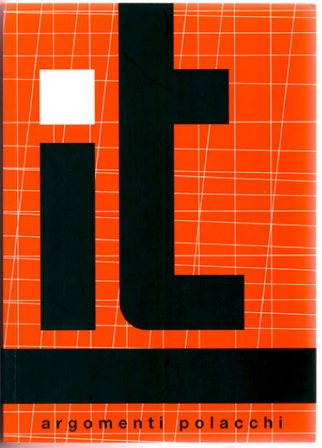
Shadows and reflections of the city; Considerations on the urban imagination; Polish fiction after 1989;
More...
Il presente articolo è una concisa presentazione dei risultati della ricerca esposta nella tesi di dottorato dal medesimo titolo.
More...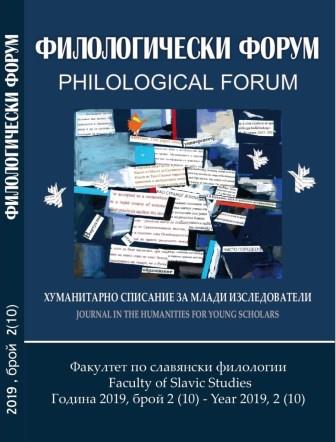

![Polskie nazwy pojazdów lotniczych na podstawie Wojskowego słowniczka lotniczego polsko-francusko-niemiecko-rosyjskiego [1922]](/api/image/getissuecoverimage?id=picture_2020_55202.jpg)
The paper is based on an analysis of names of aviation vehicles included in the Wojskowy słowniczek lotniczy polsko-francusko-niemiecko-rosyjski (Military Polish–French–German–Russian aviation glossary), published in 1922. The lexemes are examined in terms of the origin (whether they are loan-words or of Polish origin) and their structure in order to determine the rules underlying this linguistic process. Extralinguistic factors and events are also taken into consideration in the analysis, e.g. the development of Polish aviation, the social tendencies in the 1920s, conditions of military service.
More...